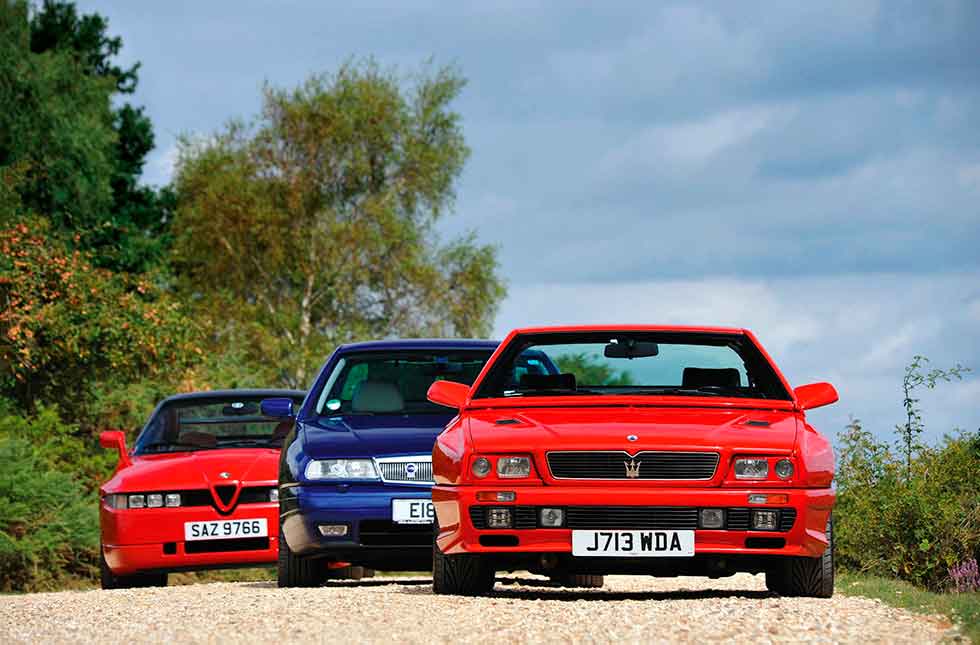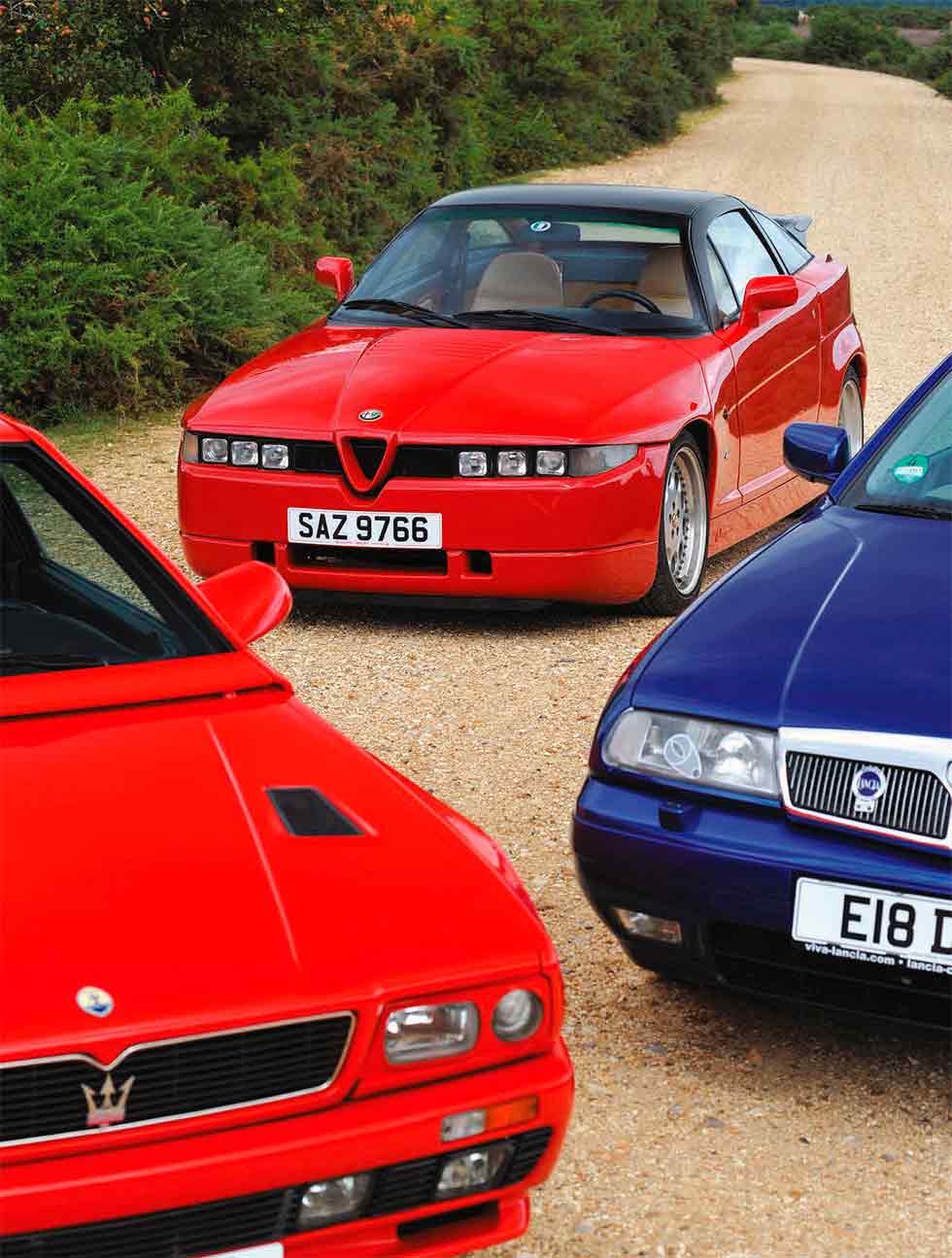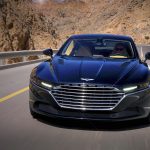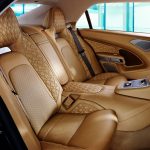
Winning Ugly. Hit by an ugly stick? Maybe. But there’s beauty in this trio of beasts. From the brutal energy of Maserati’s Shamal, through the monstrous Alfa SZ to Lancia’s quirky Kappa Coupe, Italian style doesn’t have to be delicate to have appeal. Story by Chris Rees. Photography by Michael Ward.
Maserati Shamal vs. Alfa-Romeo SZ and Lancia K Coupe Triple test of ugly ducklings with inner beauty…
Beauty, they say, is in the eye of the beholder. If so, then ugliness is, too. The trio of cars we’ve gathered here have variously been beheld as misshapen, awkward, monstrous and brutal to the point of hideous. In Italy, they even called one of them Il Mostro – the monster.

Yet I’m here to argue that not only is their very ugliness an essential part of their appeal, but they also have a captivating inner beauty. All three have a peculiarly individual charm that goes beyond aesthetics.

After all, it’s not as if these cars are ugly by accident. There is method in their apparent design madness. The stylists of each are stellar creators. The Maserati Shamal was designed by Marcello Gandini (who did the Lamborghini Miura and Countach), the Alfa Romeo SZ by Robert Opron (Citroen SM, Renault Fuego) and the Lancia Kappa Coupe by Enrico Fumia (Alfa 164, Alfa GTV/Spider 916).

If history has judged these cars akin to Macbeth’s three ugly witches, I’m here to present an alternative history. One where they are, with every justification, loved and appreciated. These ugly ducklings are triumphant swans. Fly, my uglies, fly.
MASERATI SHAMAL: THE BRUTE
A Biturbo with brawn? That’s just one aspect of Maserati’s most extreme model of the 1990s – well, actually 1980s, since it was unveiled in December 1989, just before De Tomaso relinquished control of Maserati to Fiat. Extreme rarity is another aspect: in its six-year production life, a grand total of just 369 Shamals were made.
When you meet the Maser, it broods at you, its aggression barely contained. The original Biturbo shape is just discernible under massively fattened arches, 1980s side skirts and none-too-subtle slabs of bumpers. To me, it looks like the love-child of a Coke bottle and Kryten from Red Dwarf. Details collide in a kaleidoscopic frenzy: Gandini’s signature slanted rear wheelarch profile; the bold black B-pillars; the banks of eight lights up front; the bonnet’s purposeful cooling vents; and the extraordinary spoiler at the base of the windscreen (to deflect air and water from the wipers).
The ‘brawn’ aspect continues under the bonnet, with an all-aluminium V8 engine with twin IHI turbochargers – basically the engine that would eventually make it into the 3200 GT. Fire it up and you know you’re in for a blast. This was a very quick car by 1990s standards, and it still is: 0-62 mph in 5.3 seconds and 170mph tops. Having two turbochargers ensures the torque curve is beefily linear; or at least, it is once it’s on boost. The first turbo kicks in above 2500rpm, merging seamlessly with the second one to become stronger and stronger as the revs rise. Peak torque has already arrived at 2800rpm, but you’re seduced to explore the upper ranges where the boost and noise are phenomenal. Objectively, there’s no point blitzing the 6500rpm limiter but it’s intoxicating to hear the low-rpm growl give way to a full symphony of whistling turbos and chattering wastegates.
The six-speed Getrag manual ‘box is brilliant, if old-school mechanical in feel, with a heavy clutch pedal to match. That somehow fits the car’s brutish persona, as does the driveline shunt. While the Shamal can sometimes be a beast to drive, it’s actually pretty relaxing as a GT, with excellent refinement and 29mph per 1000rpm in sixth gear.
The weight distribution – pronouncedly over the front wheels – means the rear end feels light and the wheels can spin up, even in the dry. No rain fell during our test drive but the car’s owner – Clive Bate of Emblem Sports Cars – reports that it can snap in the wet without warning, despite the presence of a quite sophisticated differential. The steering is precise and fairly fast-acting (three turns lock-to-lock) but perhaps lacks a little feel. The Shamal lacks ABS, but the brake pedal is well servo’d and quickly hauls the 1417kg car to a halt.
All Shamals have Koni adaptive suspension, with four selectable damping rates via a switch that looks like a 1980s TV remote. But even on the softest setting, body roll is well controlled thanks to a hefty front anti-roll bar and a smaller rear one. The cabin is a wonderful place to spend time: a feast of leather, polished wood and Alcantara. The seats are supportively bolstered yet comfy. The lenticular clock has the whiff of fine jewellery and the wooden steering wheel adds an aristocratic air. It can even carry four people at a push, and the boot’s very usable, despite being encroached upon by a diff cooler and fuel swirl pot.
Overall, then, the Shamal is a real driver’s car. This exquisite left-hooker example feels superbly tight, with just 40,310km on the clock and a concours trophy in the cabinet from the Maserati Owners’ Club. If you’re interested, it’s for sale at £69,995 via Emblem Sports Cars (www.emblemsportscars.com).
TECHNICAL SPECIFICATIONS MASERATI SHAMAL
ENGINE: 3217cc V8 DOHC twin turbo
MAX POWER: 326hp @ 6000rpm / DIN
MAX TORQUE: 322lb ft (436Nm) @ 2800rpm / DIN
TRANSMISSION: Six-speed manual, rear-wheel-drive
SUSPENSION: MacPherson struts, anti-roll bar (front); semi-trailing arms, anti-roll bar (rear), adjustable dampers
BRAKES: Vented discs (front), solid discs (rear)
TYRES: 225/45 ZR16 (front), 245/45 ZR16 (rear)
DIMENSIONS: 4100mm (L), 1850mm (W), 1300mm (H)
KERB WEIGHT: 1417kg
TOP SPEED: 168mph
0-62MPH: 5.3secs
VALUE TODAY: £60k-£80k
ALFA ROMEO SZ: THE MONSTER
Six lamps up front. Chiselled-from- Parmesan body lines. Dramatically curved windscreen. Carbon whale-tail spoiler. A rear end more precipitously vertical than Beachy Head. Small wonder the Italians nicknamed Alfa’s SZ ‘The Monster’.
It’s Zagato-badged but, contrary to popular belief, it wasn’t actually designed by Zagato – the Milanese company merely built it. Its creator was Frenchman Robert Opron who, as previously mentioned, also penned the Citroen SM and Renault Fuego, with which you can detect certain similarities. OK, so the design may have all the subtlety of a roughly butchered haunch of meat but it’s deceptively effective, with a wind-tunnel smooth drag coefficient of just 0.30.
I do admit to some bias in the SZ camp, in that I actually own the car pictured here (number 249 of the 1036 SZs made, an original UK-supplied example). But having lived with my SZ for over five years, I’m not blind to its quirks and foibles. It does not, shall we say, have the precision build quality of a Porsche; small children could be lost in its panel gaps. And Alfa’s decision to use ‘Modar’ plastic for the body panels – something no other car maker ever did – is one that generations of owners lament, since the paint suffers from maddeningly regular bouts of micro-blistering.
But these faults are somehow all part of this utterly extraordinary machine’s charm. Inside, the quirkiness continues: exposed painted panels, tan leather upholstery and a faux-carbon dashboard. The Zagato-monogrammed seats are nicely supportive and sumptuous, although they lack adjustability. Behind the seats is an area reserved for luggage, complete with straps to keep your bags in place. The ‘boot lid’ doesn’t access a boot – that would be far too sensible, wouldn’t it? – but merely a space saver spare wheel.
The SZ shares much of its underpinnings with the Alfa 75 Group A/IMSA race car, including its coilover front suspension. Having the five-speed transaxle at the rear, where a de Dion tube sits, gives the car near-perfect weight distribution (56% front, 44% rear). That means superb balance through the bends, and any shuftiness in the back end is transmitted early and clearly, allowing you to adjust the throttle and cornering line with consummate ease.
Alfa claimed at launch that the SZ could pull 1.4g in corners, a record at the time. That was on 16-inch teledial wheels; my own SZ has 18-inch reproductions which, with 225/40 front and 255/35 rear tyres, give it even sharper turn-in. On the centre console are switches for adjustable damping but there are no ‘sport’ or ‘comfort’ modes here; the buttons simply raise and lower the ride height to overcome kerbs and sleeping policemen. In either mode, the ride remains pulverisingly hard.
As with the Shamal, the SZ does without ABS (reportedly Alfa deliberately didn’t fit it because that’s what racing drivers preferred). The SZ’s brakes aren’t very strong, so fitting uprated Ferodo DS2500 pads on my example has given a much meatier feel.
The 3.0-litre Busso V6 is a thing of glory. It’s not super-powerful, though, despite Alfa uprating the fuel injection, camshaft timing, compression ratio and intake and exhaust manifolds. The result is 210hp; modern diesels have more grunt. But the exhaust note is glorious, helped in this case by a oneoff system which has muscular oomph at the low end and a searingly sparkling top.
Just 95 SZs currently exist in the UK, according to AROC SZ Register records. Which is still loads more than either the Shamal (nine) or Kappa Coupe (unknown but surely the fingers of one hand would suffice). You’d be winning ugly in any of these cars, but the public doesn’t get to see them very often…
TECHNICAL SPECIFICATIONS ALFA ROMEO SZ
ENGINE: 2959cc V6 SOHC
MAX POWER: 210hp @ 6200rpm / DIN
MAX TORQUE: 181lb ft (245Nm) @ 4500rpm / DIN
TRANSMISSION: Five-speed transaxle, rear-wheel-drive
SUSPENSION: Wishbones, coil springs, anti-roll bar (front); de Dion tube, anti-roll bar (rear)
BRAKES: Vented discs 284mm (front), 250mm (rear)
TYRES: 205/55 ZR16 (front), 225/55 ZR16 (rear)
DIMENSIONS: 4059mm (L), 1730mm (W), 1311mm (H)
KERB WEIGHT: 1256kg
TOP SPEED: 152mph
0-62MPH: 7.0secs
VALUE TODAY: £30k-£60k
LANCIA KAPPA COUPE: UGLY DUCKLING
Quirky. Attention-grabbing. Full of character. The Lancia Kappa Coupe is all of these things. Few would argue, however, that it is a masterpiece of elegance. Lancia described it, at launch, as having “sophisticated understatement and great character” comparable to the Flaminia Coupe and Gamma Coupe. Er, really Lancia?
There’s something distinctly ‘off’ about the proportions; wheelbase too pinched for the car’s height, overhangs too falollopy. The frameless doors look nice but the rear window’s being flanked by two ‘tail fins’ – a supposed reference to the Flaminia Coupe – doesn’t work terribly well.
But it sure has charm. And significance, because this was the last coupe Lancia ever made. Designed in-house by Centro Stile Lancia, it debuted at the 1996 Turin Show, although it didn’t reach market until April 1997. It was dropped in March 2000 because the plain fact was, it was a sales flop. Lancia’s forecast of 3000 units a year proved wildly optimistic: in the end only 3263 coupes were made in three years.
Aesthetics aside, the main reason why demand was slender was the price. It was built by Maggiora – at the same factory that made the Delta integrale and Fiat Barchetta – and was essentially a handmade car, which bumped up the price to luxury levels (although not in the UK, where it was never sold).
The front end, right up to the windscreen, is identical to the Kappa saloon’s, but it’s entirely different from there backwards. The coupe’s shape is kiboshed by its compact wheelbase (120mm shorter than the saloon’s). Lancia tried to make amends with a wider rear track but to little avail. The rear lights, by the way, are taken direct from the 1990s Delta (the one we never got in the UK), albeit divided by a chrome strip.
The engine range was interesting. The five-cylinder 20V of ‘our’ Kappa – one of only 837 built with this powerplant – comes straight from the Fiat Stilo Abarth. This 2.4-litre five-pot has decent flexibility for a non-turbo engine, with a smooth torque curve at relatively low rpm and a peak of 175hp, as well as a very charismatic soundtrack.
If you wanted more power, you could choose a 205hp 2.0 four-cylinder turbo (top speed 146mph, 0-62mph in 7.3 seconds), which was superseded in 1998 by the 220hp Fiat Coupe 20V Turbo five-cylinder lump. For more relaxed touring, the best choice was a detuned Alfa Busso 3.0 V6 (204hp, 137mph, 0-62 in 9.8 seconds), which in the Kappa was only ever offered with automatic transmission. As for the five-speed manual gearbox fitted to ‘our’ car, this works well, even if has a rather long and rubbery action. Helping to put the power down via the front wheels is a Viscodrive viscous coupling, which means you can hoof the throttle early on corner apexes, although the steering can feel heavy when you do. The all-strut suspension does a good overall job of balancing ride and handling. Despite Lancia calling the tyres “low profile” at the time, their 55 section is pretty lofty by modern standards. On 16-inch alloys, the ride is very good, even if the handling suffers from comfort-orientated settings, even with the optional adjustable damping set to ‘Sport’. It’s plush inside, with a very Italian feel.
Standard gear includes climate control, electric Recaro seats, and Lancia even offered a very early sat nav option. Alcantara upholstery was standard, with Poltrona Frau leather optional – including some very brave ‘Kaleidos’ colours, such as vivid green, violet and turquoise. The Coupe is more of a 2+2 than a four-seater but I still managed to squeeze my 5ft 8in frame back there fairly easily. Oh, and the 500-litre boot is huge. We should add that this example, owned by Donald Smith, is for sale for £8750 – please see our classified pages for full details.
TECHNICAL SPECIFICATIONS LANCIA KAPPA COUPE 2.4
ENGINE: 2446cc 5-cyl DOHC
MAX POWER: 175hp @ 6100rpm / DIN
MAX TORQUE: 170lb ft (230Nm) @ 3750rpm / DIN
TRANSMISSION: Five-speed manual, front-wheel drive
SUSPENSION: MacPherson struts all round
BRAKES: Vented discs 281mm (front) Solid discs 276mm (rear)
TYRES: 205/55 R16
DIMENSIONS: 4567mm (L), 1830mm (W), 1425mm (H)
KERB WEIGHT: 1425kg
TOP SPEED: 135mph
0-62MPH: 8.7secs
VALUE TODAY: £3k-£10k
THANKS Many thanks to owners Clive Bate of Emblem Sports Cars (www.emblemsportscars.com) and Donald Smith for their help with this feature










